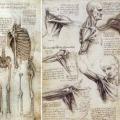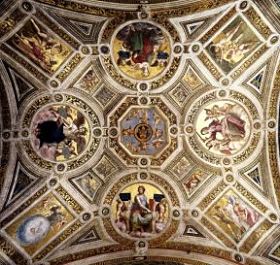361. The Measure of All Things: Renaissance Mathematics and Art
The humanist study of Pythagoras, Archimedes and other ancient mathematicians goes hand in hand with the use of mathematics in painting and architecture.
Themes:
• R. Sinisgalli (ed. and trans.), Leon Battista Alberti: On Painting (Cambridge: 2011).
---
• C.L. Joost-Gaugier, Pythagoras and Renaissance Europe: Finding Heaven (Cambridge: 2009).
• Anthony Grafton, Leon Battista Alberti: Master Builder of the Italian Renaissance (Cambridge, MA: 2002).
• M.A. Peterson, Galileo’s Muse: Renaissance Mathematics and the Arts (Cambridge MA: 2011).
• P.L. Rose, “Humanist Culture and Renaissance Mathematics: the Italian Libraries of the Quattrocento,” Studies in the Renaissance 20 (1973), 46-105.
• P.L. Rose, The Italian Renaissance of Mathematics: Studies on Humanists and Mathematicians from Petrarch to Galileo (Geneva: 1975).







Comments
Peterson's Galileo's Muse
I was flabbergasted to see that you have recommend Peterson's Galileo's Muse for further reading, as it is a truly awful book and almost completely historical crap
In reply to Peterson's Galileo's Muse by Thony Christie
Peterson
Ouch! Well, without making a general evaluation (being neither expert enough nor having read it carefully enough to publish an opinion here on someone else's work) I should say that I did at least learn about some interesting things from it, notably the part towards the end of the episode on Pacioli on the Trinity. To some extent I use "further reading" just to indicate books I drew on while working on the podcast, in lieu of footnotes. But I know you know your stuff so your comment does give me pause about, say, including it among the essential reading at the end of the book version.
In reply to Peterson by Peter Adamson
Review?
It would be helpful if there was a book review to recommend that discussed the concerns about this publication. Is there one that is recommended to read, in order to better understand the issues with the book's scholarship?
361
Magnificent!
Spectacular Episode
This episode was fantastic! Thank you so much for putting things out like this. I teach painting and this is the kind of episode I can even recommend to students who paint in a manner that derives from the Renaissance. Linking the discovery with lenses and optical rays to linear perspective, the influence of Plato, and all that jazz. Absolutely fantastic!!!
Another influence on art that began in the renaissance and lasted well into the 17th and 18th centuries was the revival of an ancient idea that Poetry and Painting were sister arts. This is found in Simonides phrase that gets translated "poetry is a speaking picture, painting a silent poetry", and is most famously given expression by Horace as "ut pictura poesis"- as is painting, so is poetry. This association of painting and poetry had major implications when Aristotle's Poetics was recovered during the Renaissance through a Latin translation of an Arabic version written by Averroes. From this Aristotle's ideas on drama were applied to the arts of painting and sculpture. I am crossing my fingers that there might be an episode that deals with that coming up in the future. It would certainly compliment this episode.
Anyway. Bang up job!!!!
In reply to Spectacular Episode by Professor Pain…
Art and philosophy
Thanks, glad you liked the episode! I'll look out for a chance to get in that interesting idea about painting and poetry, that is really cool.
In reply to Art and philosophy by Peter Adamson
Ut Pictura Poesis
There is a good essay entitled Ut Pictura Poesis: a Humanistic Theory of Painting by Rensselaer W. Lee that goes quite a bit into the influences (both good and bad) that this the association of painting and poetry had on generations of art and art theorists. It mentions a few people you’ve already brought up in this podcast series as well as others- all of it revolving around Horace and Aristotle’s Poetics. Check it out if you’re interested. https://www.collegeart.org/pdf/artbulletin/Art%20Bulletin%20Vol%2022%20…
Pronunciation
I invite you to look up the correct pronunciation of the name girolamo, hopefully before you record the next episode.
In reply to Pronunciation by Silvia
"Girolamo"
Oh, I see, the stress is on the second syllable. Thanks for flagging this!
For what it's worth the pronunciation of Sanksrit in the India episodes was even worse, so Italian speakers should count their blessings. And wait until we get to China!
In reply to "Girolamo" by Peter Adamson
Made my day"
Sorry for commenting unnecessariy, but I can't help it. It really made my day to read this comment
Thank you
Thank you for another outstanding episode! I found that your introductory remarks, aside from explaining that genius runs in your family, segue into the overall theme of the episode in that genetics also has its own field of algebra/mathematics.
Add new comment